Share this
7 Types of Content Marketing Every Roofing Company Should Know (+Examples)
by Eliza Spain on May 03, 2023

Are you tired of creating content that doesn't resonate with your audience?
Do you feel like you're constantly throwing content out into the void without real impact?
Fear not, because content marketing can be a game-changer for businesses looking to boost their online presence and connect with their audience.
In this blog post, we'll be sharing seven real-life examples of successful content marketing campaigns that you can use as inspiration for your content strategy.
These examples prove that with the right approach, content marketing can be a powerful tool for creating brand awareness, building trust with buyers, and increasing revenue.
So, let's dive in and explore the possibilities of content marketing.
Content Marketing for Driving Sales and Success
Using content is a practical approach to explain your services and engage with your target audience. You can guide customers on what to do before, during, and after using your services by providing valuable tips and information.
Recent research from HubSpot reveals that 45% of consumers spend an hour or more per week watching video content on platforms such as YouTube and Facebook–this demonstrates the growing popularity and effectiveness of using video as a marketing tool.
When you consider that 65% of people are visual learners, 90% of information that comes to the brain is visual, and presentations with visual aids are 43% more persuasive, it makes sense to use content types that people have an innate psychological resonance with.
Neil Patel
[Source]
In general, we’ve found seven types of content marketing (in both written and video format) that are most likely to bring in revenue and get you the sales and marketing results you want.
We’ve also found that these types of content can shorten the sales cycle. It allows for prospects to navigate your services and get to know your company. Therefore building trust and allowing the buyer to have all the information necessary before making a purchasing decision.
The seven types of content marketing that will deliver marketing and sales results include:
- FAQs: Address common questions asked about a product or service and provide helpful information.
- Employee Feature: A great way to introduce your team to potential customers.
- Showcase Products and Services: Help educate your target audience about your offerings and discover who is/is not the right fit.
- Landing Page Content: Designed to drive conversions by providing information and setting expectations.
- Cost or Pricing Information: Includes information on the pricing structure and factors affecting cost of your service.
- Success Stories: Show how your services have been effective for customers in the real world, establishing proof and validation.
- Support Claims About a Product or Service: Show the authenticity of your statements regarding your identity and the products or services you offer.
Let’s dive a little deeper into the types of content and how you can use them in your content marketing strategy. We also list some great examples of roofing businesses doing this on their websites.
1. FAQs
To create effective FAQs (Frequently Asked Questions) for your website, you should consider including information about your product or service, installation process, shipping and returns policies, payment methods, account information, privacy and security policies, and any other relevant information.
Answering the top 5-10 most common questions salespeople get asked is a good place to start for FAQs.
Written FAQs can be published on your website or in blog posts, while video FAQs can be created and shared on websites, social media platforms, YouTube, or directly with prospects.
Both formats effectively provide helpful information to your audience and can increase customer trust and satisfaction.
The Metal Roofing Channel (from Sheffield Metals) creates a variety of content that educates, informs, and engages their audience while establishing themselves as an authority in the metal roofing industry.
Their videos are a great resource to find answers to all your roofing inquiries and concerns, including metal roofing components, issues, expenses, and comparisons.
2. Employee Feature
Employee feature content can provide a behind-the-scenes look at your company and its employees, allowing customers to get to know you better. This can be used to showcase the skills and experience of the team members and build trust with potential customers.
Written content can be an "About Us" page on your website, while video content can be shared on social media and your website.
On their Meet Our Team page, Texas State Roofing Company does a great job of highlighting their team of skilled roofing professionals that are dedicated to delivering top notch workmanship and exceptional customer service. They each have dedicated bios to show off their experiences, expertise, and personalities.
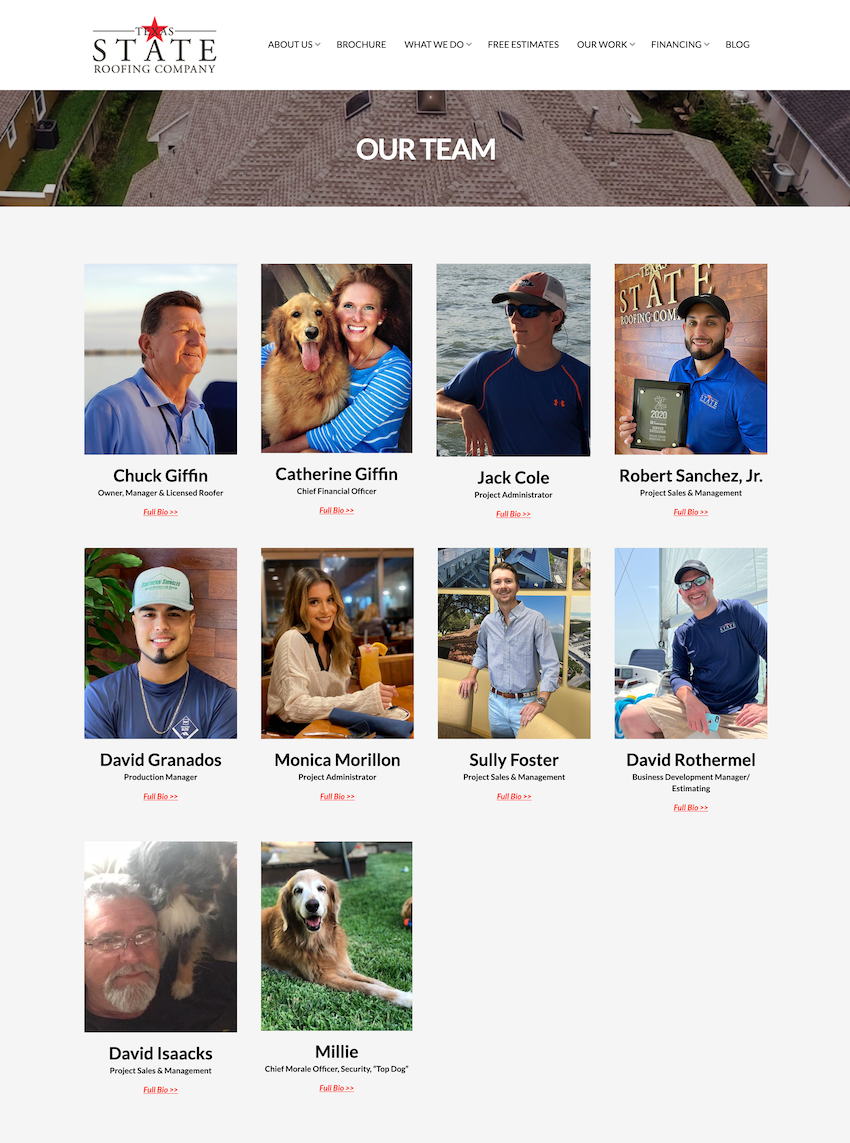
3. Showcase Products and Services
Video content that effectively communicates the value proposition of your products or services can be product demonstrations, customer testimonials, or explainer videos. You can increase customer interest and improve conversions by providing helpful information about your products and services.
Written content can be blog posts, landing pages, or product descriptions on your website.
Bill Ragan Roofing Company does a great job of showcasing the products' features and benefits in a more immersive and memorable way than traditional text-based marketing.
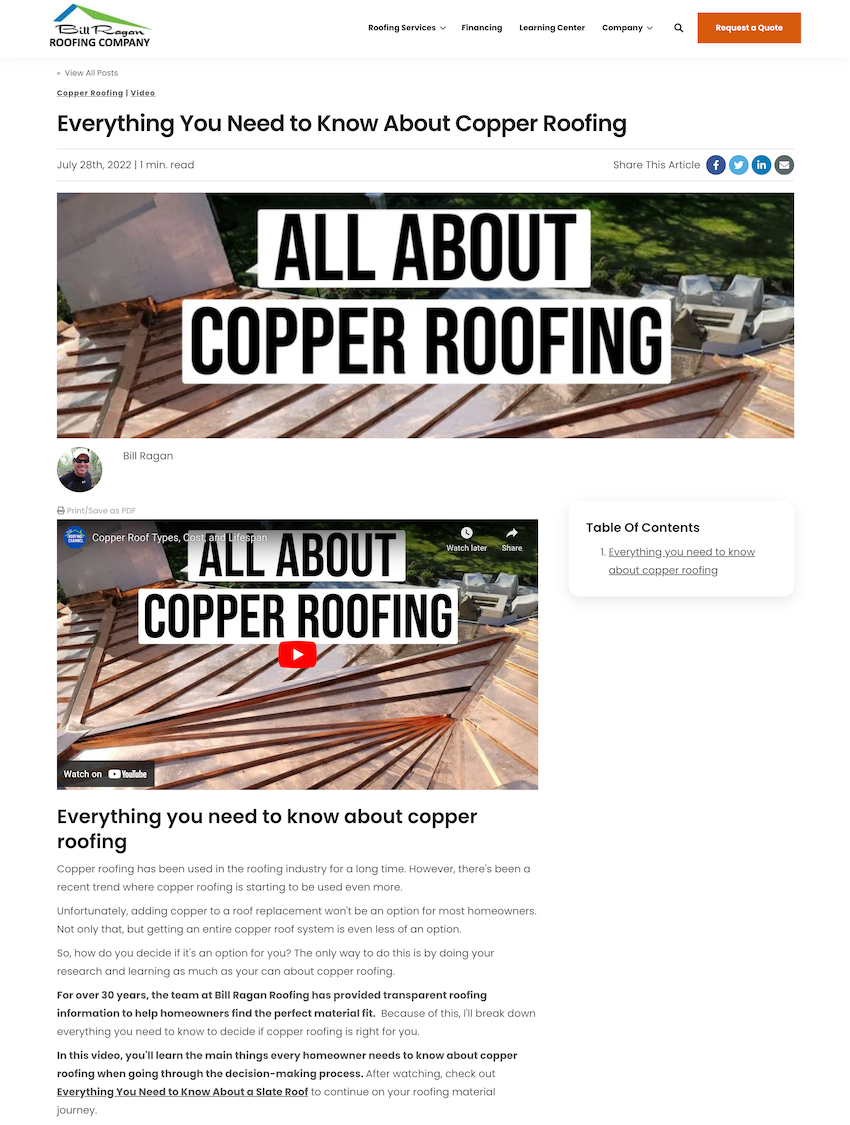
4. Landing Page Content
Landing page videos are a powerful tool that can help alleviate potential customers' fears and concerns and build trust in your brand.
These videos allow visitors to experience your message with minimal effort, making it easier to see the value in sharing their information with your company.
Written landing page content can include clear value propositions, product benefits, and testimonials. Adding text around why a prospective customer should fill out your form will help build trust and hopefully remove any doubts they may have about giving their information.
JBL Roofing and Construction provides an excellent example of how the content used on your landing page can help convert visitors into opportunities.
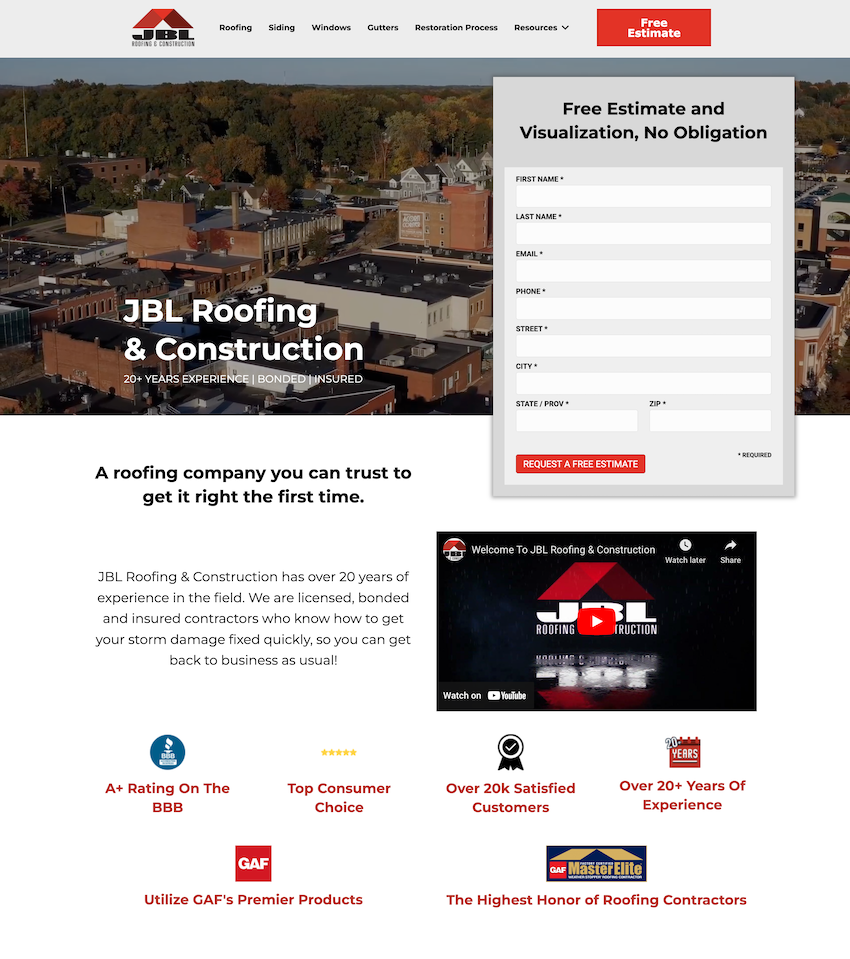
5. Cost or Pricing Information
Providing pricing or cost information can help potential customers make informed decisions.
Written pricing content can be included on product pages or blog posts, while video content can consist of explainer videos.
By being open about pricing, you can establish trust and credibility with your audience, ultimately leading to more conversions. Incorporating pricing and cost information on a website can offer advantages such as transparency, efficiency, a competitive edge, and attracting more qualified opportunities.
If you’re worried about displaying your pricing on your website due to competition, it’s likely competitors already have a good understanding of your pricing structure. On the other hand, customers may be deterred if you don't openly discuss pricing and will go looking somewhere else.
Your services are likely to be customized to some extent so you must be willing to openly discuss the various factors that affect cost.
Holladay Grace Roofing makes it easy for customers to determine the cost of a new roof replacement without any guesswork. They provide comprehensive information on the expected expenses for a roof replacement in 2023. [Holladay Grace is a Manage Inbound client]
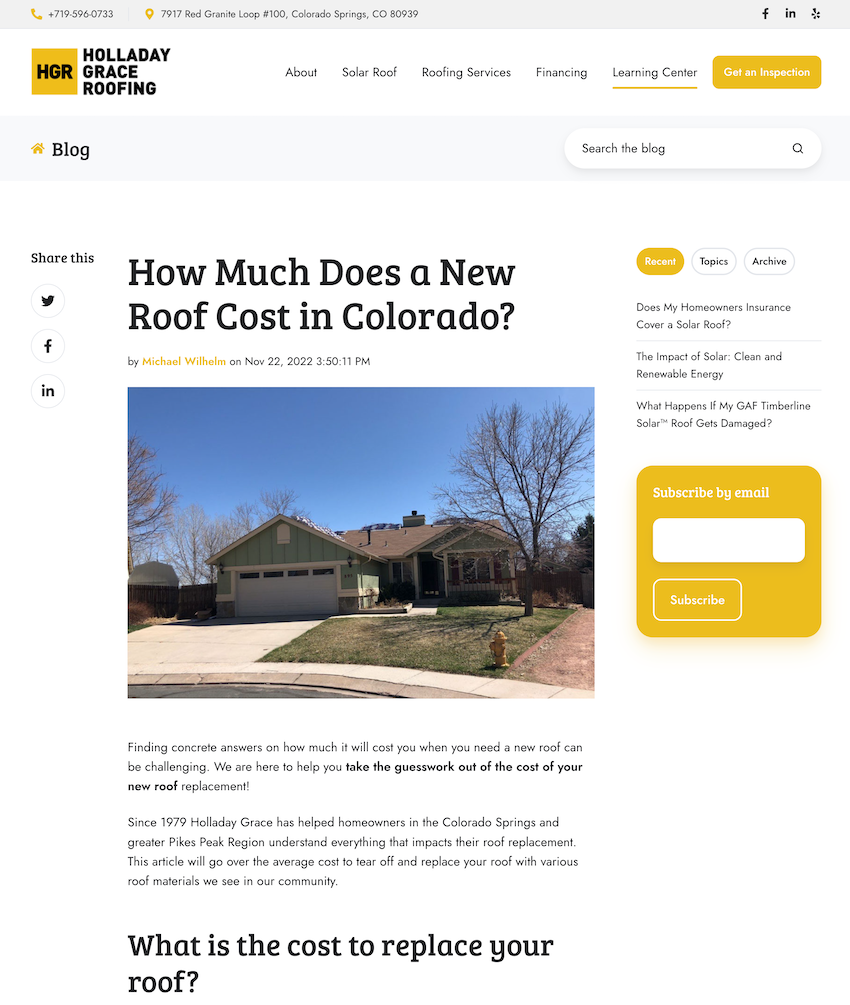
6. Success Stories
Customer success videos can provide social proof and build trust with potential customers. These videos showcase customer success stories or testimonials, highlighting how your product or service has helped others.
By seeing how your offerings have benefited real customers, potential customers are more likely to trust and engage with your business.
By exhibiting its brand personality and values, Tadlock Roofing establishes a deeper connection with its audience. They prioritize transparency, authenticity, and helpfulness in their content, which enables them to cultivate customer relationships and foster referrals. Check out their customer testimonials at the bottom of this page.
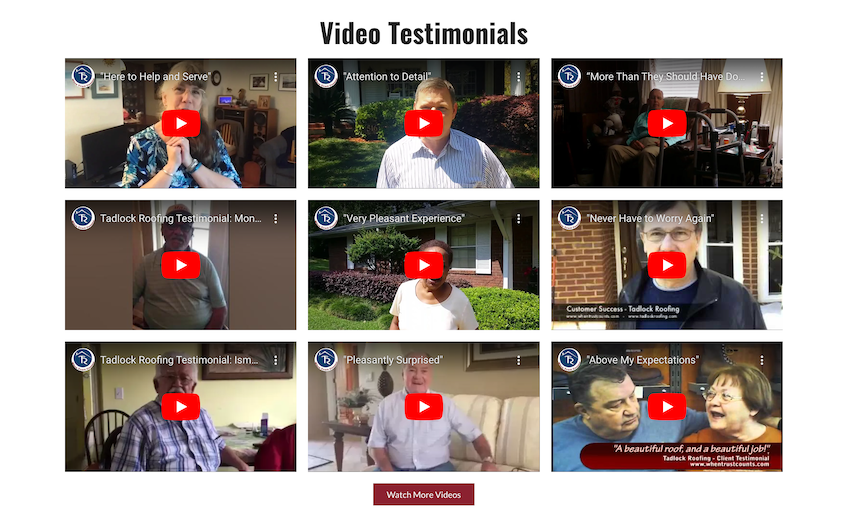
7. Support Claims About a Product or Service
Supporting the claims you make about your product or service demonstrates, rather than simply stating them, strengthens the commitments a company makes to its customers. This is an essential part of a company’s content marketing strategy, as it showcases the brand’s values, capabilities, and promises, providing tangible evidence to support its claims.
Using videos to support their claims about their roofing services and products helps Skywalker Roofing to provide potential customers with a better understanding of what they can expect when working with the company.
It allows them to showcase their expertise and build trust with their audience, ultimately leading to more conversions and business growth.
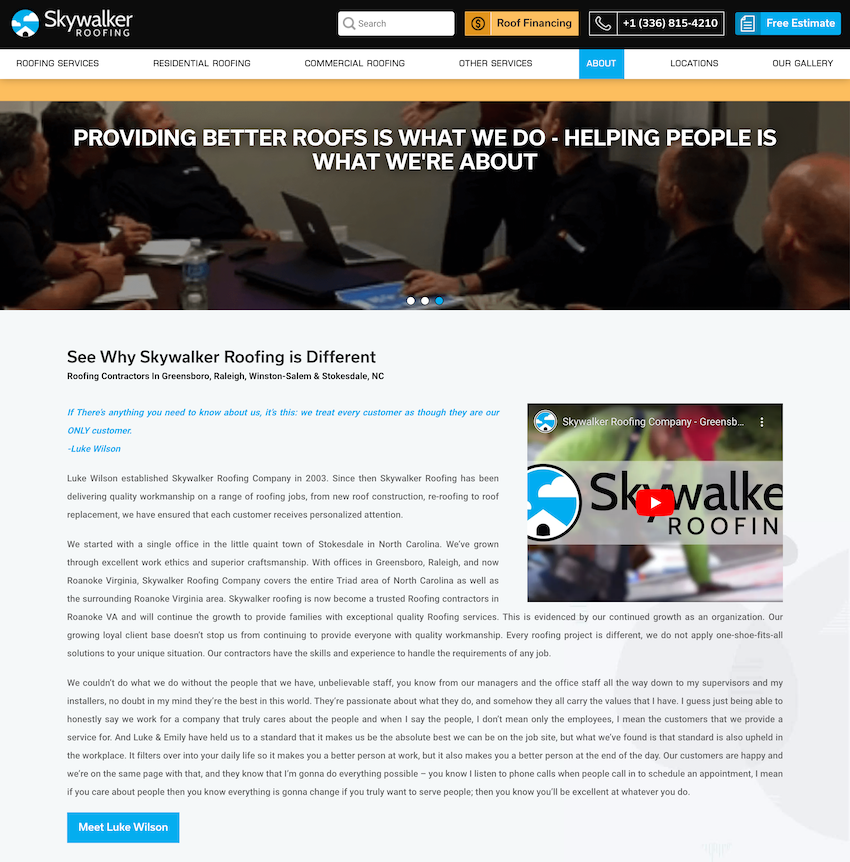
Tips for an Effective Content Marketing Strategy
Now that we've covered some key concepts related to content marketing, such as the importance of pricing and cost content, as well as the effectiveness of social proof and "proof of claims" videos, it's time to explore how you can get started with your own content marketing strategy.
Whether you're just starting or looking to revamp your existing strategy, there are several steps you can take to ensure that your content resonates with your target audience, drives engagement, and, ultimately, generates opportunities and sales.
We'll provide some practical tips and best practices to help you develop and implement an effective content marketing plan.
As we've discussed, content marketing is crucial to any successful marketing strategy. It allows businesses to engage with their target audience meaningfully, build brand awareness, and drive sales.
If you're new to content marketing, it can be overwhelming to know where to start.
We've put together some basic steps to help you start your content marketing journey:
- Define your target audience: Who are you trying to reach with your content? What are their pain points, interests, and needs? By understanding your target audience, you can create content that speaks directly to them and addresses their unique challenges.
- Set your goals: What do you want to achieve with your content marketing strategy? Are you looking to shorten the sales cycle, generate more opportunities, or increase sales? Once you've identified your goals, you can create a strategy that aligns with those objectives.
- Choose your content types: There are many different types and formats of content you can create, including blog posts, videos, infographics, whitepapers, and more. Consider which types of content will be most effective in reaching your target audience and achieving your goals.
- Develop a content calendar: A content calendar is a schedule of when and where you'll publish your content. By planning out your content in advance, you can ensure that you're consistently posting high-quality content that resonates with your target audience.
- Have someone own content: An in-house content manager who owns content creation is essential for content marketing. They develop and implement a strategy that reflects an authentic brand voice, oversee the creation process, ensure quality and SEO optimization, and analyze performance. This individual leverages content to engage the audience, generate leads, and increase revenue for the business.
- Create and publish your content: Once you've developed your content plan, it's time to start creating and posting it. Be sure that the sales team shares content with prospects. Utilize content on social media and track your results to see what's working and what's not.
- Measure your results: Finally, measuring the effectiveness of your content marketing strategy is essential. By analyzing your results, you can make data-driven decisions to improve your content marketing strategy over time.
By following these basic steps, you can start your content marketing journey and see actual results for your business.
Remember, content marketing is a long-term strategy that requires patience and persistence, but with the right approach, it can help you achieve your business goals and take your brand to the next level.
Conclusion
Content marketing is a powerful tool for companies to connect with potential customers and showcase their expertise in the industry.
By providing helpful tips, advice, and inspiration, businesses can build trust with their audience and establish themselves as a go-to resource for all things related to a specific product or service.
As the examples above show, roofing companies that use content marketing effectively can attract new customers and position themselves as thought leaders in their area, driving long-term success and growth.
Have questions?
Schedule some time to talk with us today with any questions!

No Comments Yet
Let us know what you think